Want to elevate your AI conversations and stand out as a professional? Whether you’re exploring text generation or image generation, we’ve got you covered with the latest techniques to master Generative AI.
How can you become an expert at engaging with Generative AI? In this article, we’ll explore ten essential prompting techniques derived from our experience developing our own GPT model. These techniques are also inspired by insights from industry sources like ZDNET and WIRED, and can be applied not only to ChatGPT and Midjourney but also to other text-based and image-based AI systems.
Let’s first talk about the generative AI prompting sessions we conducted this spring. These 30-minute sessions were offered free of charge and provided valuable insights into using tools like ChatGPT and Midjourney. Due to popular demand, we’re excited to announce that new sessions are just around the corner. Stay tuned for more details. In the meantime, let’s explore ten prompting techniques to take your AI conversations to the next level.
1. Talk to the AI like you’d talk to a person
When you chat with AI, treat it like you’re talking to a real person. Believe it or not, research shows that you can make ChatGPT perform 30% better by asking it to think about why it made mistakes and come up with a new prompt that fixes those errors. This is exactly how humans learn and improve their skills through reflection.
2. Set the stage and provide context
To get the best answers from ChatGPT you need to set the stage and give it some context. Just asking a short question won’t do the trick. Take the time to provide relevant background information that helps ChatGPT understand the situation better. By giving the AI more details, you’ll receive a more focused and helpful answer that addresses your specific needs.

Prompt not providing context: “Give me five email subjects that will make people book trips!”
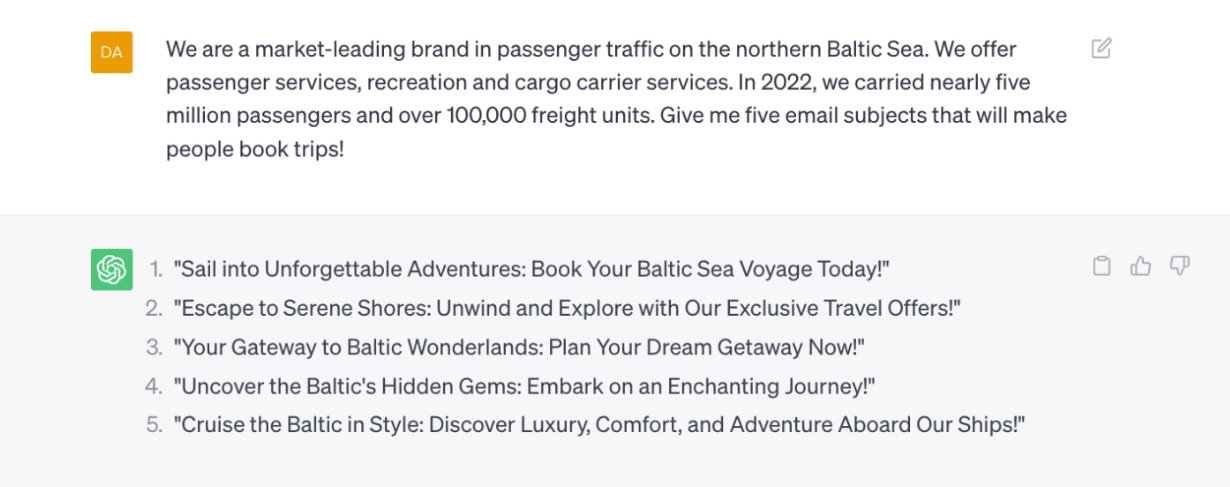
Prompt providing context: “We are a market-leading brand in passenger traffic on the northern Baltic Sea. We offer passenger services, recreation and cargo carrier services. In 2022, we carried nearly five million passengers and over 100,000 freight units. Give me five email subjects that will make people book trips!”
3. Tell the AI to assume an identity or profession
Did you know that ChatGPT can transcend its default, often dull and matter-of-fact tone? With careful prompting, you have the power to transform its responses into something far more captivating. Just like a versatile actor embracing different roles, ChatGPT can skillfully mimic the style of specific individuals or professions – like an enthusiastic teenager or a frustrated salesman. This ability adds a whole new dimension of creativity to your AI conversations, which you can apply in your work.
4. Get ready-to-use answers in table form
Did you know that ChatGPT can provide answers in table format? All you have to do is ask. By using follow-up prompts and plain language, you can have ChatGPT create tables and even format them in a way that can be easily understood by programs like Microsoft Excel. This feature allows you to organise information effectively and integrate ChatGPT’s insights into your work seamlessly.
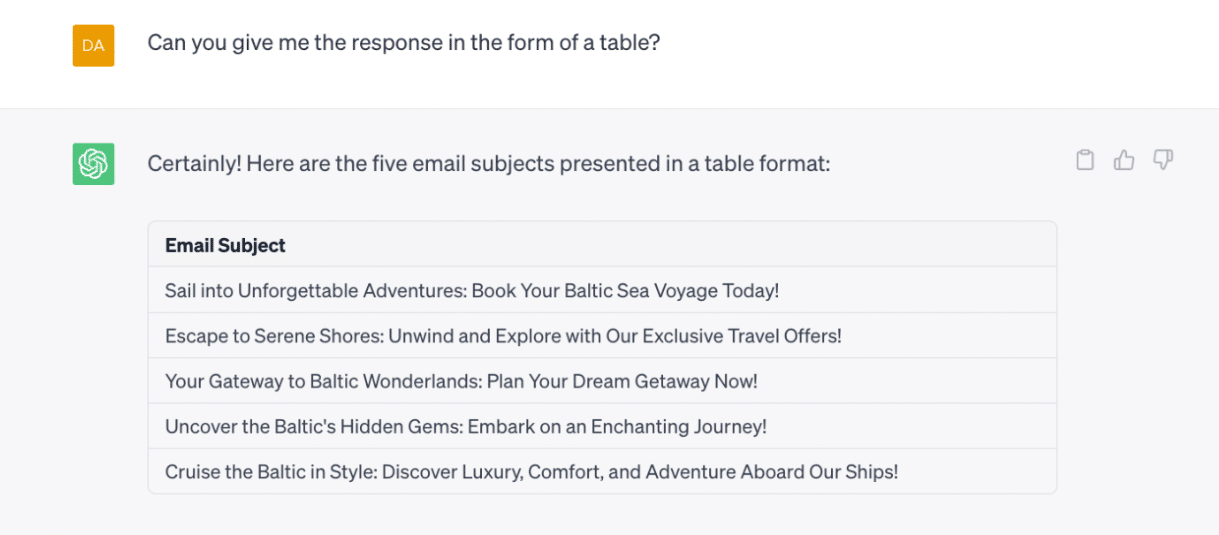
Prompt asking for a table: “Can you give me the response in the form of a table?”
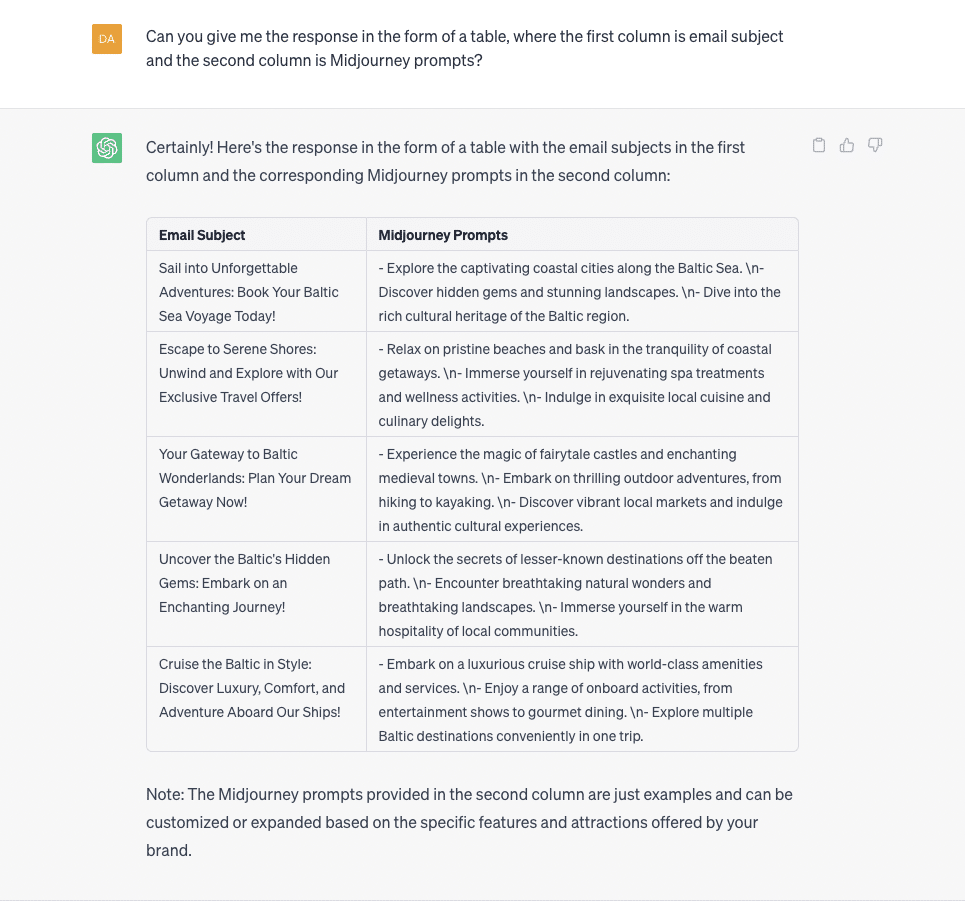
Prompt making changes to the table: “Can you give me the response in the form of a table, where the first column is email subject and the second column is Midjourney prompts?”
5. Set constraints to get better answers
When engaging with ChatGPT, set limits on the answers you receive. As a talkative AI, ChatGPT benefits from constraints. You can request answers that are more concise, such as condensing information from four paragraphs into one. You can even ask for responses with fewer than seven characters to keep things simple. If ChatGPT doesn’t align with your instructions at first you can correct it, and it will try to give you a better response. Doing this will bring you closer to the tailored answers you need.
6. Keep your audience in mind
Whether you specify that you’re speaking to 10-year-olds or a group of business entrepreneurs, ChatGPT will adjust its responses accordingly. This feature is particularly useful when generating multiple outputs on the same topic. For example, you can explore the importance of unlocking business value from customer data using AI and automation tailored to your specific audience. When you keep your audience in mind, ChatGPT becomes a powerful tool for effective and tailored communication.
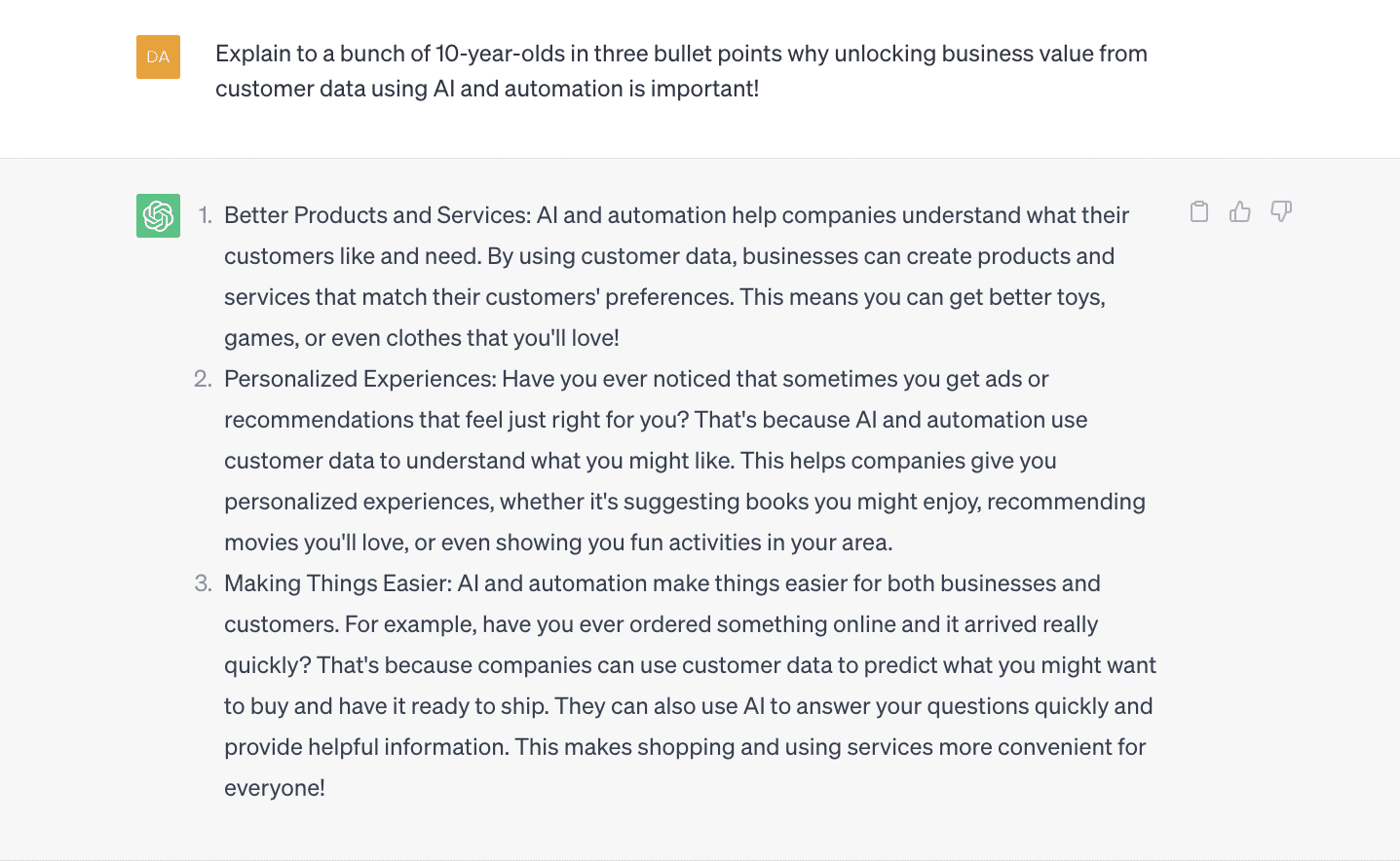
Prompt keeping one audience in mind: “Explain to a bunch of 10-year-olds in three bullet points why unlocking business value from customer data using AI and automation is important!”
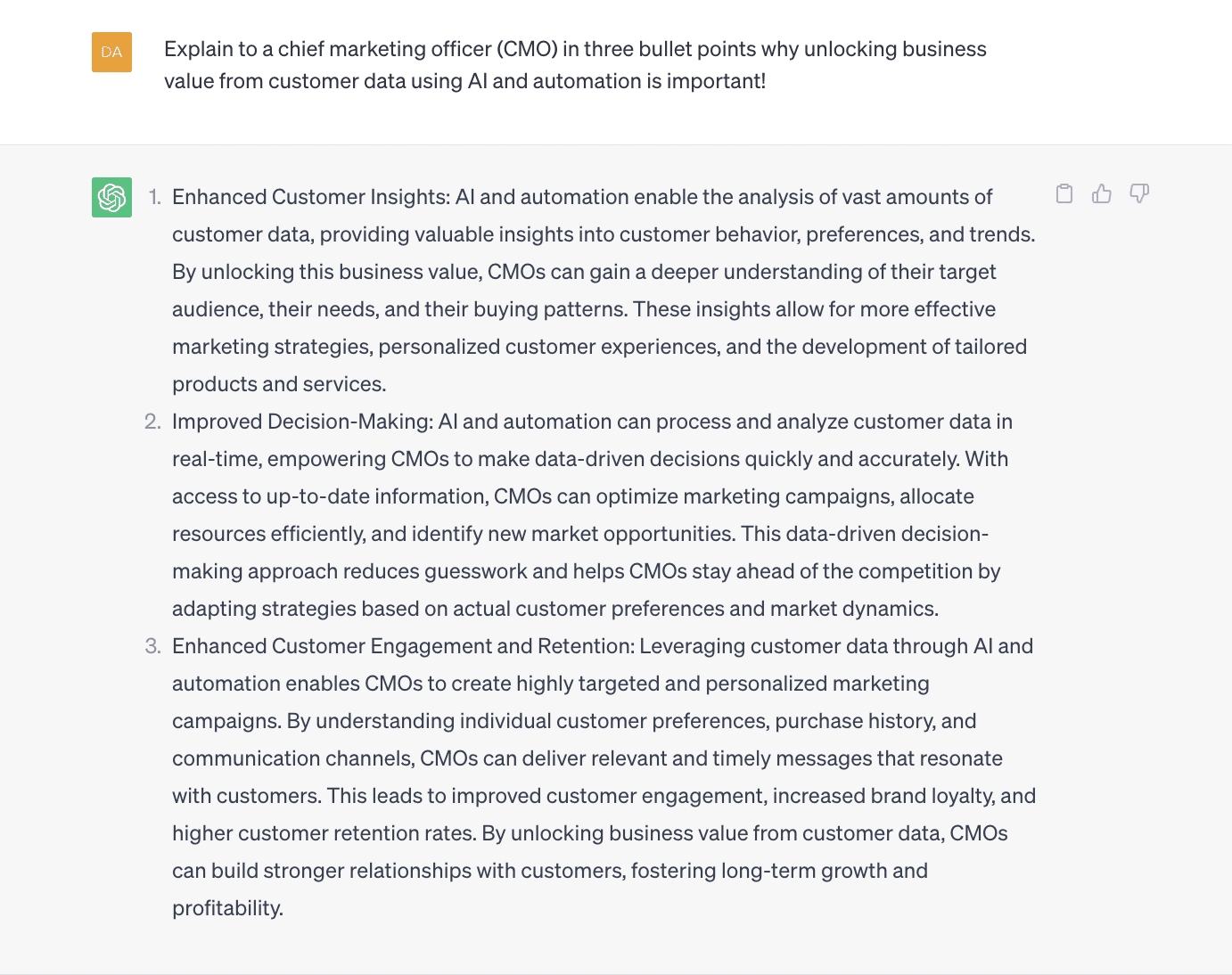
Prompt keeping another audience in mind: “Explain to a chief marketing officer (CMO) in three bullet points why unlocking business value from customer data using AI and automation is important!”
7. Copy and paste text from other sources
When it comes to ChatGPT, you don’t have to do all the typing yourself. Copy and paste becomes your ally, allowing you to effortlessly bring in text from other sources. Although there’s an input limit of around 4,000 words, you can easily split your text into sections and ChatGPT will remember what you’ve previously said. Alternatively, you can use the TLDR prompt (short for “too long didn’t read”) to summarise lengthy content.
8. Provide examples to ChatGPT can work with
An effective way to enhance the responses you receive from ChatGPT is by providing it with examples to work with before posing your question. The beauty of this approach is that there’s no fixed formula of words you must use. Simply express yourself naturally, and ChatGPT will understand your intent. To get started, specify you are offering examples at the beginning of your prompt, and then instruct it to provide a response based on those examples.
9. Give the right input and get exceptional answers
As mentioned earlier, you can greatly improve the quality of your answers by providing ChatGPT with ingredients to work with before asking for a response. These ingredients can be literal, such as suggesting a dish using items from your fridge, or they can be any other relevant inputs. In digital marketing, for example, you can provide ChatGPT with old email subjects to fuel its generation of fresh ideas.
10. Bring nuance into the debate
Tired of one-sided debates? ChatGPT can bring nuance into your arguments. With its ability to argue both sides of any topic, it presents pros and cons effectively. For digital marketing, this can mean asking ChatGPT to provide arguments for and against the suggested new email subjects. By engaging ChatGPT in this way, you can actively promote open and well-rounded discussions, encouraging a deeper understanding of diverse perspectives.
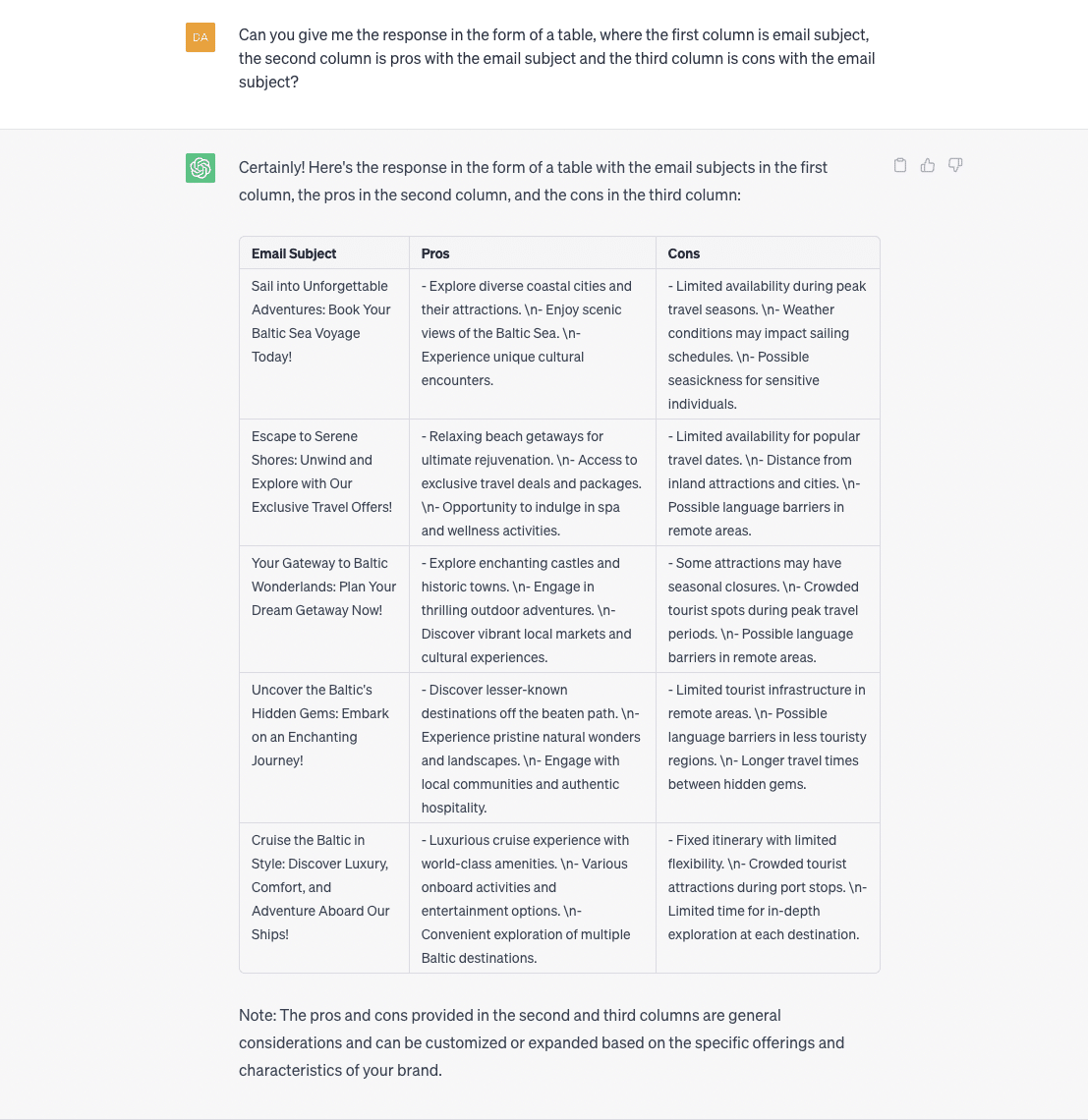
Prompt for arguing both pros and cons: “Could you provide a table response, where the first column represents the email subject, the second column lists the pros related to the subject, and the third column lists the cons related to the subject?”
How much time should you dedicate to developing your skills?
On average, we should allocate 5-10 times more time to effectively handle our job responsibilities than we currently do. In other words, there’s a gap between the amount of learning we need and the time and effort we invest in it. This insightful perspective comes from Pär Lager’s book ‘Upskill and Reskill’. Lager is one of the leading innovators and experts in learning and development in the Nordic region.
Generative AI is revolutionising fields like digital marketing, sales, and service, transforming how things work. As mentioned earlier, the specialised skill of “prompt engineering” is gaining prominence. Prioritising upskilling and reskilling not only ensures success in your current role but also keeps you ahead of the competition and future-proofs your career.
So, what can you do? Adopt a mindset of continuous learning and growth and set aside time to develop your skills. This will help you to thrive in the future of work.
Related reading:
- How to create value from generative AI
- How we can help your organisation move forward with generative AI
- AvausGPT – supercharging consultancy deliveries
- CMO’s guide to generative AI
- How to catapult your marketing productivity with generative AI
- Why you need domain specific co-pilots on your AI journey
- Unlocking business value from customer data using AI and automation (video)